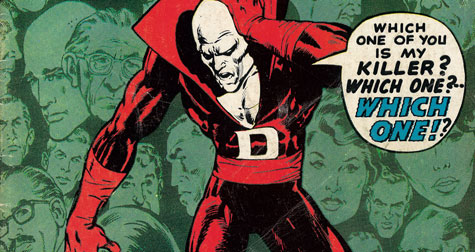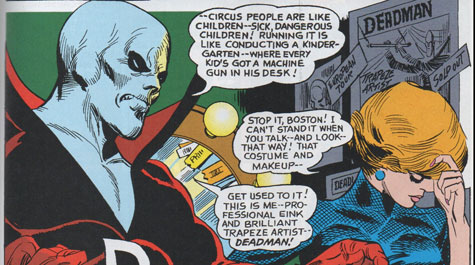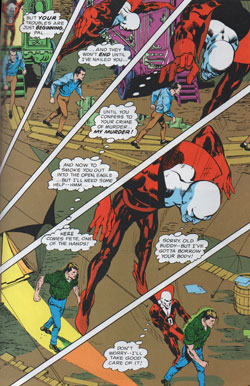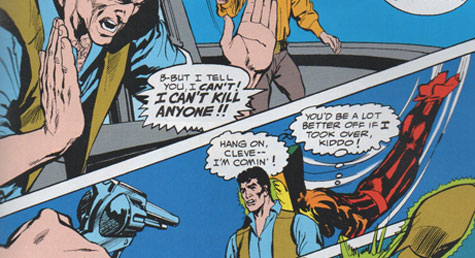
A recent query from Criminal Element asked which overlooked superheroes would be deserving of their own movie or TV show. One logical answer to that is DC's Deadman, except for one thing: Deadman has already had his TV shows and movies, many times over. Allow me to explain:
Created in 1967, Deadman was a circus acrobat with the unlikely name of Boston Brand. His act, done without a net, has him putting on a red costume with a huge stand-up collar and a sepulchral white mask and calling himself Deadman.
When Brand is killed one night in the middle of his act, he finds himself trapped not only in his costume, but also in an afterlife in which he is invisible and under the mentorship of a mysterious entity named Rama Kushna. Plus, he can enter anyone he chooses and take their bodies over, leaving them with no memories of what they did during the time of their possession.

The whole concept sounds a lot like the 1990 film Ghost; it also sounds like the TV series Quantum Leap. Add to this setup the motivating factor—Brand is using his powers to find his killer and bring them to justice—and it sounds like the film The Crow, or the TV show Nowhere Man, and even a little like the series The Fugitive, which admittedly appeared well before the comic.
So in a way, we don't need a Deadman film or TV series, because the concept has already permeated pop culture so often that putting the DC version on the big or small screen would seem derivative. But beyond the setup, there's something that makes the early Deadman stories stand out, and that is the world of pulpy noir-ish crime which they inhabit.
The early Deadman stories that ran in Strange Adventures (and later in Adventure Comics) have stakes which, for a comic book, are low and personal—Brand isn't trying to save the world or even his city, he just wants to find his killer. He's not an especially good detective, and the winding path he takes to vengeance brings him across numerous false leads, and also many people who need help.
Crime is a constant in the world of Deadman (even if the criminals he encounters are never the ones he's looking for), and Brand—who spoke with a wise-guy, up-from-the-gutter patois, which was unique among DC's heroes of the time—wasn't the kind of guy who'd ever back down from a fight, not while alive and certainly not while dead. Brand's hot-headedness while living made him plenty of enemies, but it also prepared him to take them all on.

Strange Adventures #211 had a story titled, in a lovely bit of comic-bookese, “How Close to Me My Killer?” that works as a perfect window into the hallmarks of the stories.
Deadman, having discovered a clue about his killer's whereabouts, floats over to a town in Mexico where he runs into his twin brother with an even more implausible name. Cleveland Brand—yes, Cleveland Brand—runs an operation that smuggles illegal immigrants across the Rio Grande into the U. S., all for the benefit of a corrupt congressman.
When the congressman realizes that he could be exposed, he orders Cleveland to kill all of his latest cargo—but Cleve, even facing several colleagues with guns, refuses to do it. Fortunately, Deadman takes Cleveland over, and the mortal brother gains the athletic prowess and boxing know-how of his deceased twin, allowing him to pummel his way out of potentially fatal beat-down.

This story was typical of the early Deadman stories—a crime, a man living on the fringes of the law who nevertheless has a code, a commitment to the code that puts him up against even less law-abiding men, and a scarcity of options that leads to fisticuffs. All this one's missing is the dame—you know, a good kid that’s made some bad choices, and is in a tight spot unless some passer-by wants to play Galahad.
The crime stories were gems, but one of the tenets of comics is: when you run out of ideas, pair your character up with another super-hero. So, after a couple of adventures alongside Batman, Deadman soon found himself fighting costumed tyrants and their identically-clad henchman armies with Aquaman—the usual comic book stuff. After that, it was on to similar adventures with the Justice League, a far cry from his nightclub-and-circus-sawdust origins.
Deadman's popularity definitely had a role in a subsequent influx of supernatural heroes—specifically, strange characters who frequently adventured in the afterlife—that DC published for another decade. One character in particular had made a pretty unremarkable debut over a decade before Deadman, but in 1971, he would be revived for a series that ran 41 issues, becoming an enduring hero to the DC pantheon. And it is this character who fittingly teamed up with Deadman for countless adventures over the years, that we shall follow into weird worlds next.
Check back next week as we highlight another DC superweirdo—the Phantom Stranger!
Hector DeJean can frequently be found in comic stores, bookshops, and the Eighties. His serialized story of a private detective who only solves food-related crimes is no longer online.

